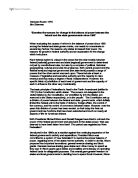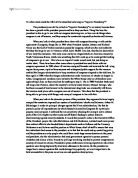Neema Daniel 13AXS
Is the USA still a federal state?
Federalism, being the distribution of power between state and national governments, has evolved dramatically since its proliferation during the founding of the US constitution to the modern US political age. However this evolution has led to a changing relationship between state and federal governments resulting in the criticism that power today has significantly shifted to the national government. It is true that federalism, as envisaged by the Founding fathers, is quite different to the 21st Century federalism; however elements of the concept continue to prevail today.
Regarded as one of the great compromises, federalism was incorporated by the founding fathers to fundamentally ensure that the distribution of political power would not result in the forming of a tyrannical, overbearing government, such being the potential attributes of the governments of a unitary state. Geographically federalism is suitable for the US political system as it would be illogical for a national (federal) government to significantly exercise power across a large landscape. The concept too also coincides well with the constitutional amendment process, featuring state ratification to validate an amendment. Federalism has significantly developed, undergoing a series of evolutionary phases from dual federalism during the time of Chief Justice John Marshall, cooperative federalism during the presidency of FDR and the growth of the new federalism movement during the presidency of Ronald Reagan.
In support of the motion, the federal (or national) government’s power has significantly increased, most prominently during the presidencies’ of George Bush and Barack Obama. The Republican president after 2001 initiated emergency powers and approved 60 measures removing regulatory powers from the state. A notable measure was his education reforms, featuring the passing of the No Child Left behind Act in 2001 and a dramatic spending increase in the department. It appeared that much was promised for the American education system yet at the price of the central government imposing the standards on all states. Additionally in relation to national security, spending dramatically increased from $290 million to $651 million between 2001 and 2009 and the Patriot Act resulted in a string of legislation that would significantly affect the conduct of security measures from in the USA affecting the lifestyles of all. Additionally after the 2008 recession the state intervened in terms of economic management; consider the $700 billion ‘bail-out’ package, thus financially the federal government took a direct role in the workings of the financial system.
It is surprising to witness a Republican president to pass measures that characterizing a government similar to that of FDR’s during the 1930s, for one would expect a policy of de-centralisation or the ‘devolution revolution’ as Ronald Reagan stated to occur during George Bushes’ presidency. Therefore it is right to assert that central government appeared to dominate the political life of this period and that the states had little involvement in the policy making process.
However one must explore the reasoning behind the passing of these measures that characterized a ‘big government’. Bushes’ presidency was largely characterised by events to which he arguably reacted to. Consider 9/11; had this event not occurred would the Patriot Act and other respective security measures be legislated for? Additionally had the financial crisis of 2008 not occurred would there be a bailout package, would the state intervene in private corporations to recover the economy? Therefore central government did not dominate the US political system for the sake of domination, rather to recover from security and financial events that required large scale intervention.








